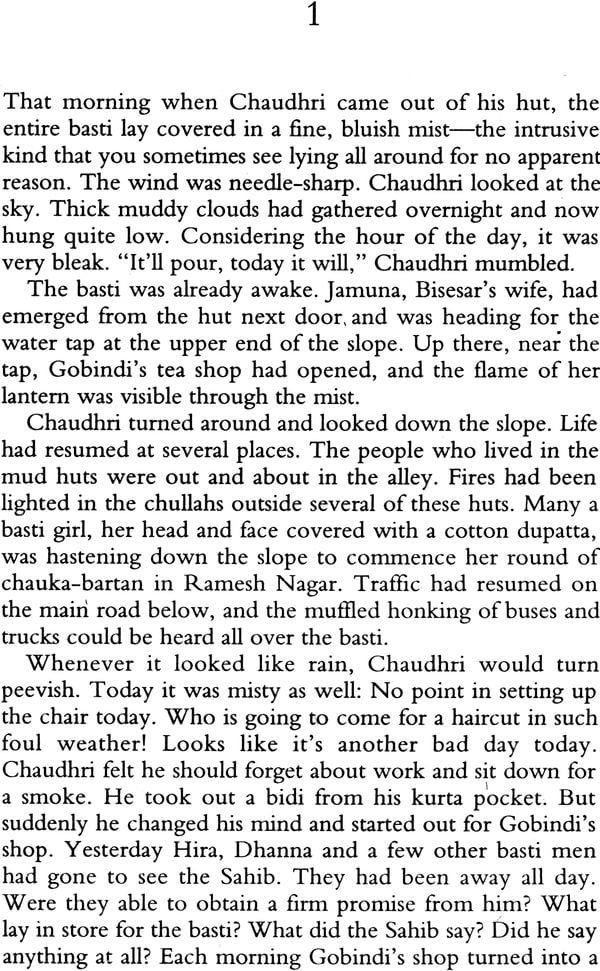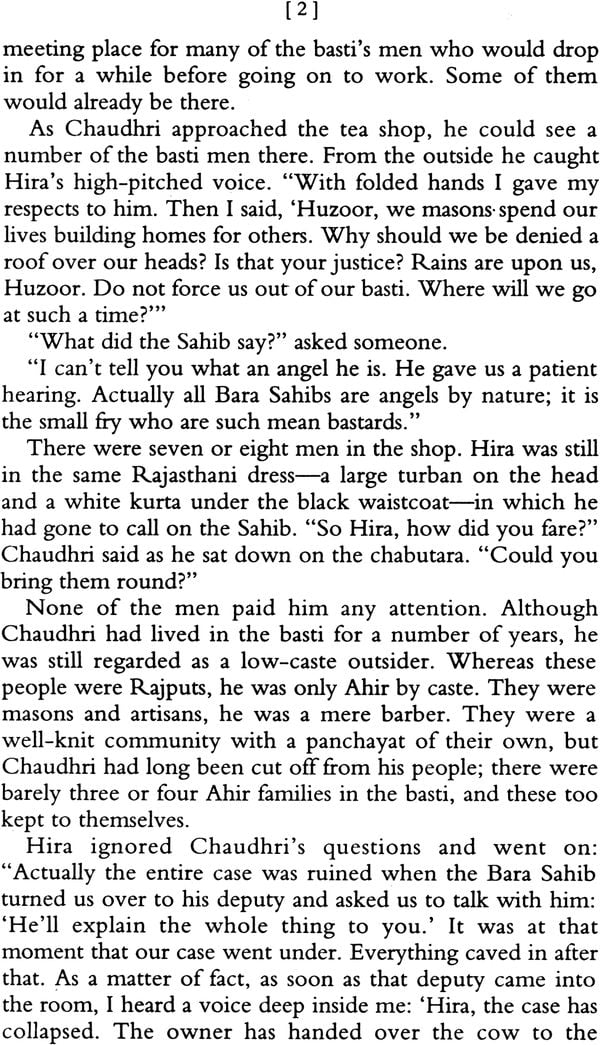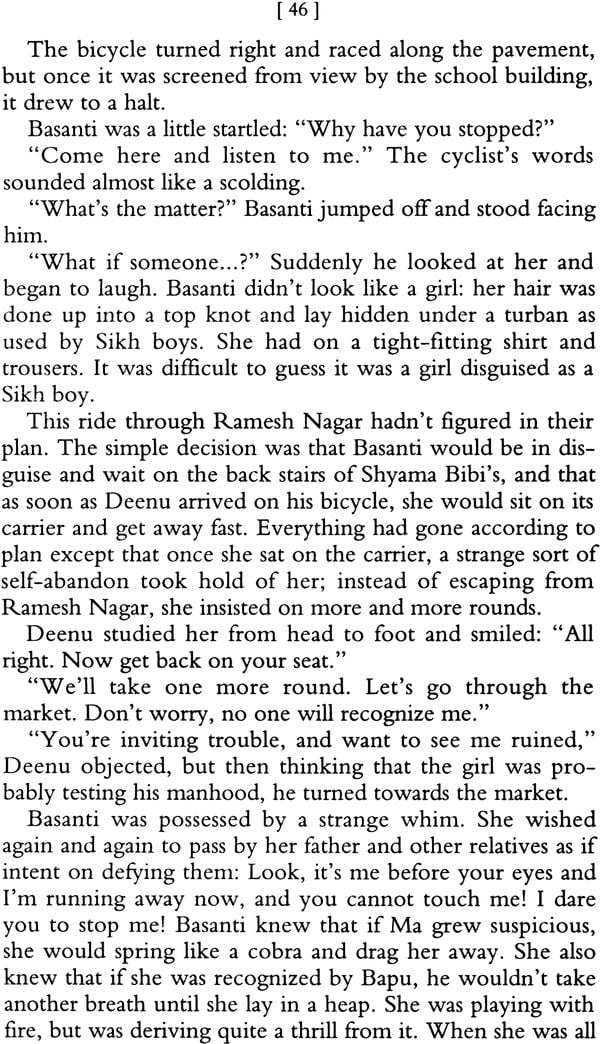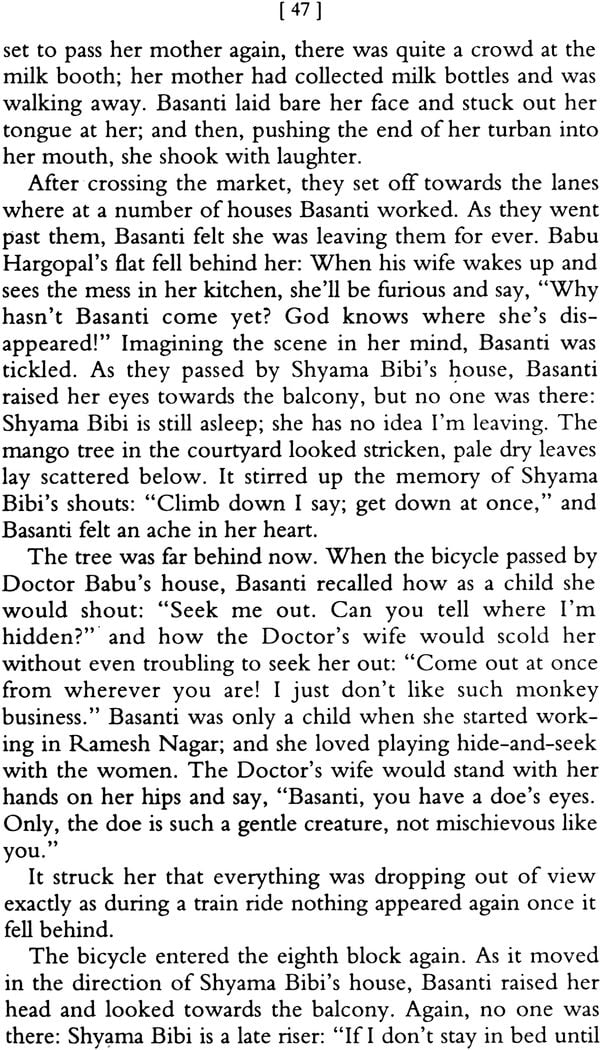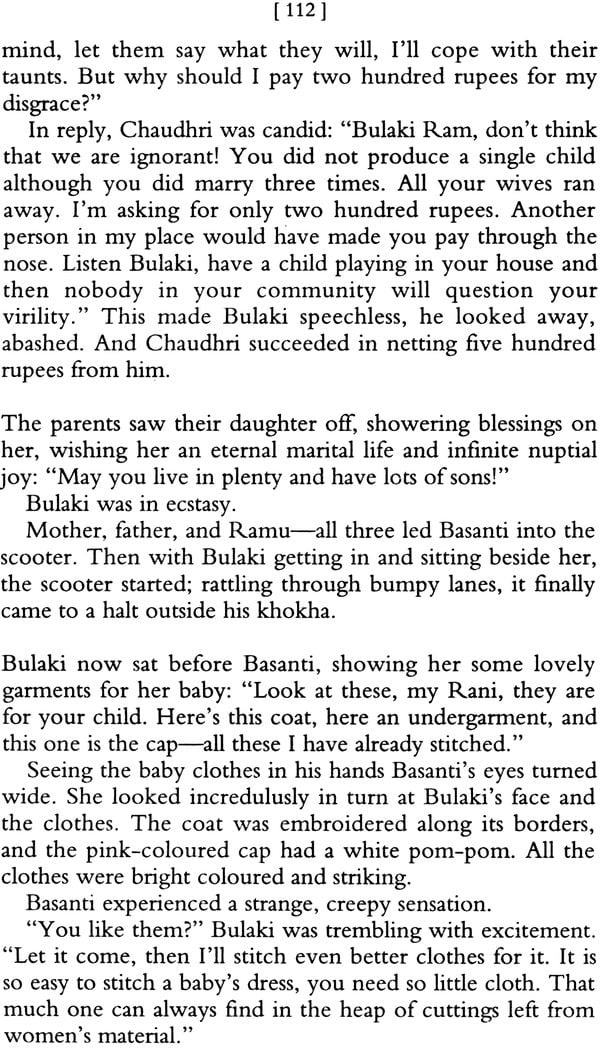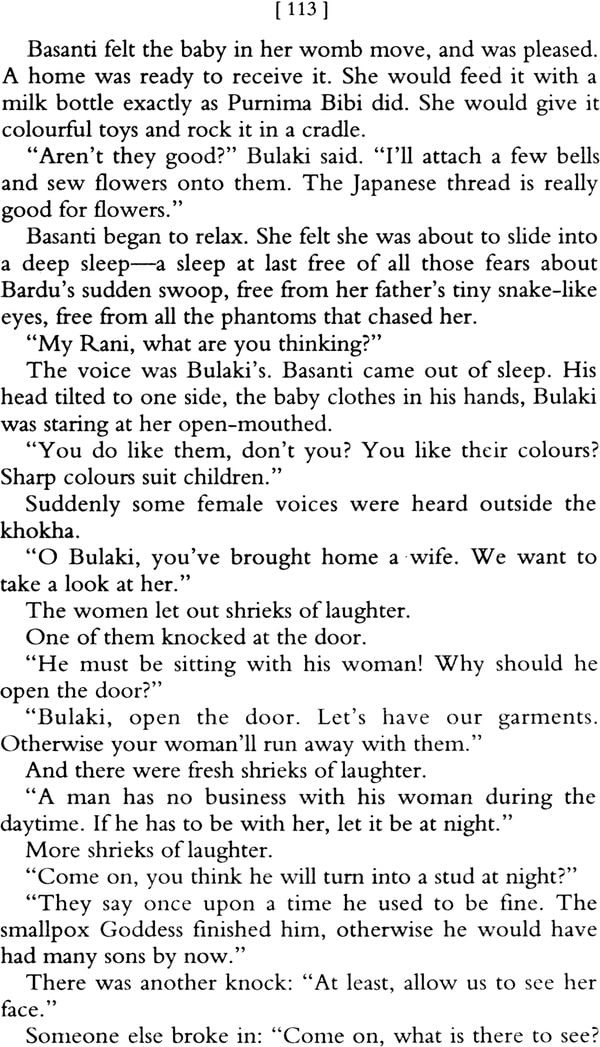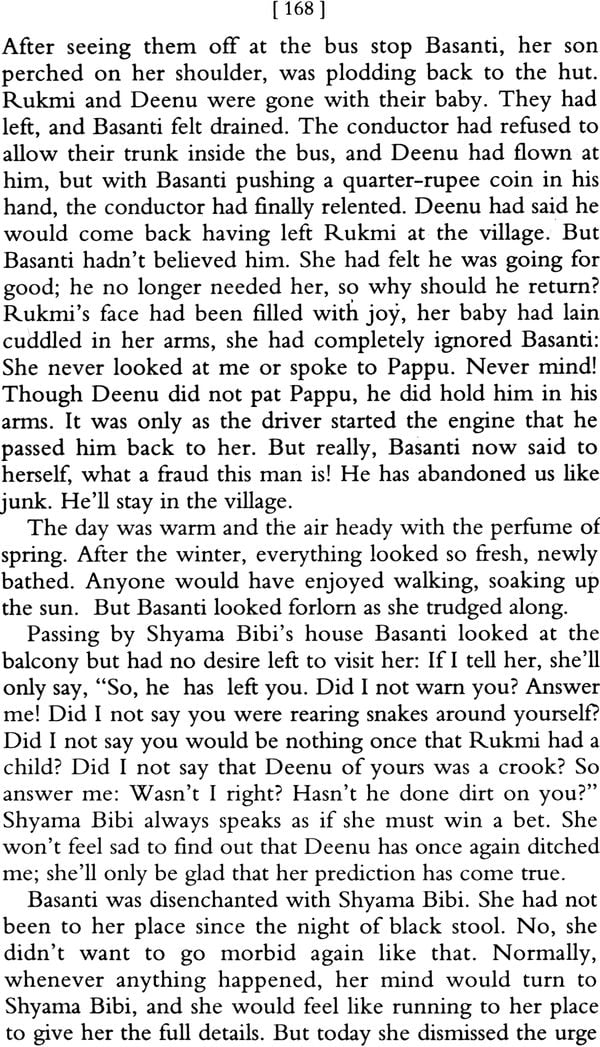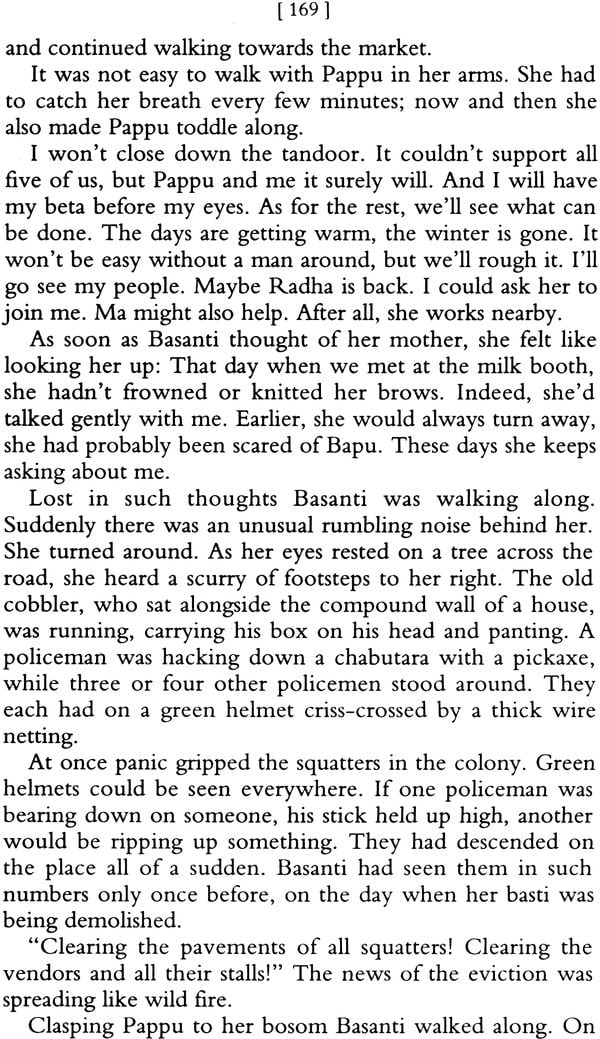
BASANTI
Book Specification
| Item Code: | IDG808 |
| Author: | Bhisham Sahni |
| Publisher: | Indian Institute Of Advanced Study, Shimla |
| Language: | English |
| Edition: | 1997 |
| ISBN: | 8185952450 |
| Pages: | 193 |
| Cover: | Hardcover |
| Other Details | 8.7" X 5.7" |
Book Description
From the Jacket
Basanti encompases the blighted springs of a low-caste teenaged girl brought up in one of Delhi's numerous ever-insecure bastis. The demolition of her basti saves the 14 years old 'working' girl from being sold off in marriage to a 60 year old lame Rajput. She rebels against her mercenary father but in vain, for the lover with whom she elopes 'like a heroine' turns out to be another mercenary. He too, sells off the pregnant girl and goes back to his wife. Basanti is daring and vivacious but all her subsequent attempts at making something of her life are thwarted by the 'regulators' surrounding her. In a resolution that is both moving and dignified, she demonstrates her firm grip on life as well as her quick ripening into a mature being unlikely to be deluded by myths about class, caste, love, marriage, and the welfare state.
As well as being a fast-developing individual in her own right, Basanti is the special site from where Sahni offers a vivid and disturbing perspective on the urban jungle which is what Delhi is for a huge chunk of its citizens.
Jaidev teaches English at the Himachal Pradesh University, Shimla. As a Fellow at the Indian Institute of Advanced Study, he wrote The Culture of Pastiche: Existential Aestheticism in the Contemporary Hindi Novel (1993).
About the Author
Bhisham Sahni was born in Rawalpindi in 1915. He took a Master's degree in English at Lahore, and a PhD from Punjab University. Prior to the partition, he had a short stint as a businessman. After 1947, he tried journalism, theatre and teaching. Life stabilized only after he joined Delhi College, Delhi as a teacher of English. He spent seven years in Moscow translating Russian texts, including Resurrection, into Hindi. Besides having edited Nai Kahanian for over two tears, Sahni has been involved in the Progressive Writers Association and the Afro-Asian Writers Association. His publications include eight collections of stories (Bhagya Rekha, Pahla Path, Bhatakati Rakh, Patariyan, Wangchoo, Shobhayatra, Pali and Nishachar), five plays {Hanush, Kabira Khara Bazar Mein, Madhavi, Muawaze and Rang De Basanti Chola}, six novels [Jharokhe, Kadiyan, Tamas, Basanti, Maiyadas ki Madi and Kunto], and a biography of his elder brother, the late Balraj Sahni, entitled Balraj, My Brother.
In 1975, Tamas won Sahni the Sahitya Akademi Award and the Sahitya Shiromani Award. It has been made into a highly acclaimed film by Govind Nehlani.
Sahni's works have been translated into a number of Indian and foreign languages. Basanti already exists in German, Russian, Kannada and Malayalam translation.
Between 1993 and 1996, Sahni was the writer-in-residence at the Indian Institute of Advanced Study, Shimla, where he completed another play, Alam Gir. At present he is working on his autobiography.
Sahni resides in Delhi with his wife Sheela to whom Basanti was dedicated in its original edition.
Some years ago, the Institute formulated a plan for developing, within its framework, a Centre for the Study of Indian Civilization. One of the major programmes of the Centre was to be the publication of a multi-volume series of books consisting of some of the finest of the creative texts written in modern times in the Indian sub-continent. Each book published in the series could either consist of representative selections of a single author from India, Pakistan and Bangladesh, or be an anthology which addresses itself to urgent literary, social, moral or political issues, which are concerned with the civilizational fate of the sub-continent. The Centre has not yet been formally established. The Institute, however, has taken a decision to undertake at least a part of the publication programme envisaged under the Centre. This is partly because we already have an ongoing publication programme and also because of the great importance of some of the texts which we have been considering. The present volume is a result of this decision. Professor Jaidev has translated Basanti from its original Hindi into English for this volume. There is also a valuable Introduction to the volume by Professor Jaidev.
Bhisham Sahni (born 1915) is one of the three or four most distinguished contemporary Hindi novelists. In the period following India's Independence the Hindi novel has thrown up talents definitely more experimental, more poetic, more extreme than him, but in terms of what, for want of a satisfactory word, must be called a mature vision, no other writer comes quite up to him. It is this vision, together with its stylistic concomitant, namely the language of insight, that runs as a thread through all of his six novels which are otherwise quite unlike one another.
Sahni consolidates the great tradition of the Hindi novel which was inaugurated by Premchand and which since then has been- enriched by Phanishwar Nath 'Renu', Nagarjuna, Krishna Sobti, Rahi Masoom Raza and many others. This tradition clings to the masses, their resistance and battles, their discourse and narratives, their proximity to oral modes of story-telling and their hybrid art forms. History (even when it is not perceived as a concept by those who encounter it), society, and community are crucial factors here, for they determine their existential space or lack of it. Although ideology is never absent, it usually operates as a set of humanistic, life-enhancing values which not only act as a valid antidote to despair and cynicism but make the writing praxis, an interventionist act.
For this tradition, history is important. It is in time that people suffer and try to make something of their lives. It is now fashionable to debunk history as dead, absurd, a fiction; and even the dead formalism is sometimes resurrected to announce that literature is (read: should be) pure and outside time and history. The tradition of Hindi fiction has no use for such dazzling cliches; its commitment - to the masses does not allow it to wallow in them. In any case, it is to this tradition that we owe our postcolonial texts. Not a postmodernist, perhaps not even a modernist in the western sense of the term, Sahni is both an important inheritor and an ambitious enricher of the postcolonial tradition in Indian literature.
Sahni also stands out as a Grand Old Man of Letters in that he is equally impressive as a short-story writer, a playwright, and a social activist. He came to the novel rather late, but when he did, in the late 1960s, the result, Jharokhe (1967) was closer to A Portrait of the Artist as a Young Man than to Stephen Hero. My invocation of Joyce is deliberate. For even though Sahni has not taken the road taken by Joyce or his hero, Jharokhe is very Joycean in its use of memory and coolly portrayed dramatic crises. Sahni the short-story writer, Sahni the playwright, Sahni the critic of culture and society, Sahni the "English teacher"- all seem to supervise and lend their individual graces to that gentle bildungsroman.
Sahni is better known for his partition novel, Tamas (1974), which in 1975 won him the Sahitya Akademi Award and in 1988 was made into a widely acclaimed TV film by Govind Nehlani. There is today little doubt that his epic novel, Maiyadas ki Madi (1988), is another major classic of the Hindi novel, as significant as Karmabhumi, Jhoota Sach, Maila Aanchal and Zindaginama.
However, from a perspective that is now gaining increasing importance for us and our plural society, namely the one in which caste, class, gender and politics appear intertwined, Basanti (1980) strikes one as no less important than Tamas or Maiyadas ki Madi.
Basanti is a Chinese box of "desperations" which together constitute the real meaning of India's political freedom for the vast majority of our people. It is a Delhi novel and thus quite appropriately seeks to be read as a national allegory. In its relentless urge for expansion, the city of Delhi sucks in the labour and lives of people whom it soon discards as dirt. These people come here from all over the country, but while the home behind is rendered more and more impossible, even their modest basti in Delhi is never secure. Any day, it can be busted by a callous state apparatus which holds out to them nothing more than bogus promises. There is no going back home (the novelist doesn't waste even a line on Spurious nostalgia for the countryside), but even in Delhi displacement returns inevitably, like seasons. A basti is built, only to be pulled down by the administration, another is built, that too is going to be demolished one day... There is something Sisyphus-like about these recurrently displaced people. Without them, though, the city would not grow.
Within this overall frame where survival is posited as the lone virtue for the victims of an inequitable class system, the novelist introduces a variety of complex threads. For the basti is not a simple, homogenized class space. It is split from inside along caste and gender lines. What the administration and its Sahibs, with the help of law and police, do to the basti, the basti Rajputs do to those below them in the caste hierarchy, and in turn the latter do the same to their daughters and wives. Chaudhri is -an Ahir and hence looked down upon by the Rajputs, though one of the disabled old ones among them goes all out to buy an Ahir girl wife. Similarly, the high-caste Deenu can use and abuse Basanti, but cannot respect her as a human being. Sexuality recognizes no caste, provided the given asymmetries remain intact. Chaudhri treats his wife as a donkey and his daughters as commodities. Outside home, Basanti is obliged to suffer the molten breath of her male employers. Patriarchy, caste, and class all converge on Basanti to blight her green spring. Even before she is sixteen, she has seen enough of men, families classes. All husbands are bastards, all lovers are bastards, all fathers are bastards, all Sahibs are bastards-these are hardly the kind of lessons a teenager should have to learn. It is a homage to her resilience and natural vivacity that she can take in all these blasts of wisdom without shedding her spontaneous laughter, her delicate dreams, or her zest for living.
For all her naivete, Basanti's presence and predicament become a mute but powerful judgement on the city, the basti, and the people she encounters, in short, on the nation. However, Sahni does not simplify the issues. The city is demoralizing but is 'also the future, hopefully less terrible than the present. Lots of films shown on TV are trash, but even when they' fail to help Basanti in her actual crises, they at least allow her to "interpret" their romantic situations in ways that are more emancipatory than the actual ways of patriarchy. It is just a chance that the demolition of the basti saves her from an unacceptable marriage. But there is nothing accidental about the way it paves the way for the loosening of caste bonds among the basti residents. The demolition of the squatters' stalls at the end similarly wakes Basanti to the basic class reality of her people so that forgetting her double tragedy she follows her mother and father to be of some use to them. The novel is mature, almost profound, by virtue of its suggestion that growth of awareness-irrespective of what adjective we attach to it: class, historical, ethical, existential-is a very slow and painful process but is important nevertheless. History batters people, tramples on their dreams, but not because it is insane or absurd but because only thus can they get to see themselves, their context, and their potential for solidarity and praxis. Basanti suffers but has a more viable definition of herself at the end. It is this philosophical and reassuring vision that accounts for the absence of rhetorical, sentimental flourishes even in scenes that would make a lesser writer turn gushy and tearful.
Basanti survives by constant adaptation, by opting for whatever comes handy or appears to be a lesser evil. At a macro level the basti people survive too. They are not angels or even mere victims, for many cling to superstition, caste-snobbery, passivity and lethargy. But the point that the novel makes again and again is that a system which cannot even recognize them as human beings, let alone offer them minimum security or a sense of participation, necessarily brutalizes and wastes them. The city is a necropolis, and who can blame them if they internalize its “ethics” or extend them to their own mates and relations.
